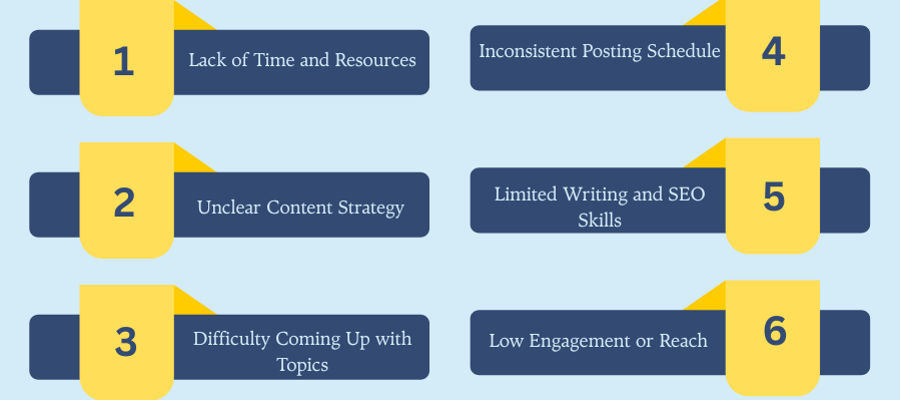Blogging Tips for Fitness Studios
Summary: Blogging enables fitness studios to enhance their visibility, engage local audiences, and establish trust through the creation of valuable content. Key strategies include understanding your audience, using local SEO, sharing success stories, and maintaining a consistent posting schedule. Combining content planning with the right tools and performance tracking ensures your blog drives results and supports long-term business growth.
Key Takeaways:
- Blogging is essential for fitness studios to increase visibility and build community trust.
- Understanding your audience ensures your content resonates and drives engagement.
- SEO and local keywords help attract nearby clients searching for fitness services.
- Consistent, well-planned content builds credibility and supports long-term business growth.
- Visual content and success stories make blogs more relatable and persuasive.
Struggling to stand out in a saturated fitness market? You’re not alone. Many fitness studios offer great workouts but still fail to attract consistent traffic or convert curious visitors into loyal clients. The missing link? A powerful content strategy that connects, educates, and builds trust with your audience, starting with a well-executed blog.
Blogging isn’t just about writing. It’s about storytelling, sharing expertise, and showcasing the transformation your studio offers. When done right, it becomes a magnet for organic traffic, a tool for local visibility, and a silent salesman that speaks to your ideal clients 24/7. Let’s explore how blogging can turn your fitness studio into a go-to wellness brand.
Table of Contents
Toggle- Why Blogging is Essential for Fitness Studios
- Common Blogging Challenges for Fitness Studios
- Quick Glance: 10 Blogging Tips for Fitness Studios
- Top 10 Blogging Tips for Fitness Studios to Boost Engagement
- Must-Have Blogging Tools and Resources for Fitness Studios
- Expert Blogging Services By Agha DigiTech for Fitness Studios
- Final Thoughts
- Frequently Asked Questions (FAQ's)
Why Blogging is Essential for Fitness Studios

Blogging plays a crucial role in helping fitness studios grow their brand, connect with their audience, and generate consistent leads. Blogging is more than just a marketing add-on; it’s a vital tool for attracting, engaging, and converting potential clients. A consistent and informative blog can position your studio as a trusted authority, enhance online visibility, and foster stronger relationships with your local audience. Here’s why blogging matters for fitness studios:
- Lack of Time and Resources: Regular blog posts improve your website’s search engine rankings, helping potential clients find you when they search for fitness tips or gyms near them.
- Builds Authority and Trust: Informative content on fitness, nutrition, and wellness positions your studio as a credible expert in the eyes of both clients and search engines
- Engages and Educates Your Audience: Blogs give you a platform to answer common client questions, share success stories, and keep your community informed and motivated.
- Drives More Website Traffic: Every blog post is a new opportunity to bring visitors to your website through organic search, social shares, or email campaigns.
- Supports Your Sales Funnel: Blog content can guide potential members from awareness to decision-making by showcasing your services, trainers, and client results.
- Provides Content for Other Channels: Your blog can fuel your social media posts, newsletters, and paid ads, saving you time and ensuring message consistency.
Common Blogging Challenges for Fitness Studios

While blogging offers strong benefits, many fitness studios struggle to maintain a successful strategy. From inconsistent posting to unclear messaging, these obstacles can reduce impact and limit reach. Understanding the most common challenges can help you avoid mistakes and build a blog that truly supports your studio’s growth.
- Lack of Time and Resources: With daily operations taking priority, most studio owners don’t have time to plan, write, or promote blog content regularly.
- Unclear Content Strategy: Without a focused plan, blogs can feel random or irrelevant, failing to connect with the target audience or support business goals.
- Difficulty Coming Up with Topics: Many struggle with generating fresh ideas that balance education, promotion, and engagement.
- Inconsistent Posting Schedule: Irregular updates can confuse readers and hurt your SEO performance, making it harder to build momentum.
- Limited Writing and SEO Skills: Even when ideas are there, turning them into compelling optimized content is a skill that many teams don’t have in-house.
- Low Engagement or Reach: Without proper promotion, even well-written blogs can go unnoticed, limiting their impact on traffic or lead generation.
Quick Glance: 10 Blogging Tips for Fitness Studios
Before diving into each tip, here’s a quick overview to help you understand what truly drives blog success in the fitness industry. From knowing your audience to tracking results, these strategies lay the foundation for higher engagement, better SEO, and more client conversions.
Blogging Tip | What It Means | Effect on Business |
Know Your Audience | Identify who you’re writing for based on goals, age, fitness level, and needs. | Improves relevance, builds trust, increases client engagement. |
Create a Content Calendar | Plan topics in advance to stay consistent and aligned with marketing goals. | Ensures consistency, supports campaigns, boosts brand visibility. |
Write SEO-Friendly Posts | Use keywords, structure, and metadata to improve search rankings. | Drives organic traffic and increases lead generation. |
Showcase Client Success Stories | Share real transformations to build trust and inspire prospects. | Builds credibility and attracts new clients through social proof. |
Mix Up Your Content Formats | Use blogs, videos, infographics, and interviews to keep content fresh. | Enhances user experience and boosts engagement rates. |
Answer Common Client Questions | Address FAQs to educate readers and reduce sales objections. | Reduces consultation time and speeds up conversion. |
Promote Your Blogs on Social Media | Share posts across platforms to increase reach and engagement. | Increases traffic and strengthens online presence. |
Use Local Keywords | Target location-specific terms to attract nearby fitness seekers. | Improves local search rankings and attracts walk-in clients. |
Include Calls-to-Action (CTAs) | Encourage readers to book classes or subscribe to your mailing list. | Boosts conversions and turns readers into paying customers. |
Track Performance and Improve | Use analytics to refine your strategy and boost results over time. | Enhances ROI and helps scale content strategies effectively. |
Top 10 Blogging Tips for Fitness Studios to Boost Engagement
Want to make your fitness blog work harder for your business? These proven tips go beyond the basics to help you connect with the right audience, boost engagement, and generate measurable growth. Whether you write in-house or use professional blog writing services, applying these strategies can transform your blog into a powerful marketing asset.
1. Know Your Audience
Knowing your audience is the first and most critical step in creating impactful blog content. Understand their fitness goals, challenges, habits, and preferences—whether they’re beginners looking for weight loss tips or athletes seeking performance guidance. The more you know, the more relevant and compelling your content becomes.
Use tools like Google Forms, client interviews, or social media polls to gather insights. Creating detailed customer personas helps tailor your blog tone, topics, and solutions to match their expectations. When your content speaks directly to them, it fosters trust, boosts engagement, and enhances retention.
2. Create a Content Calendar
A content calendar helps you stay consistent and organized with your blog strategy. It ensures your posts align with studio campaigns, seasonal trends, and audience interest. Planning also minimizes last-minute rush and content gaps that can hurt SEO and visibility.
You can use free tools like Google Sheets or project platforms like Trello or Notion to create a monthly blog plan. This allows you to balance content types such as educational, promotional, client stories, or FAQs, and schedule blog releases ahead of time. A consistent posting rhythm also signals reliability to both search engines and your readers.
3. Write SEO-Friendly Posts
SEO-friendly blog posts ensure your content is discoverable by your target audience on search engines. Begin with keyword research focused on location and services, like “online strength training for beginners” or “Pilates studio in Jaipur.” Place these naturally in your headings, body, and metadata.
Maintain clear formatting with headers, short paragraphs, internal links, and optimized images. Don’t forget mobile optimization and fast load speeds. The result? More organic visibility, higher ranking on Google, and increased traffic from people actively searching for fitness solutions you offer. Good SEO can transform a blog into a top lead-generating tool.
4. Showcase Client Success Stories
Client success stories build credibility, trust, and emotional connection with potential clients. These stories demonstrate how your fitness programs create real, lasting results. Include transformation photos, testimonials, or even short video interviews that showcase milestones, challenges overcome, and goals achieved.
Focus on relatable journeys that resonate with your target audience. Share not just physical changes, but also mental and emotional wins. Highlighting these stories shows that your fitness studio delivers value, motivates prospects, and positions your brand as results-driven. They also make great shareable content for social media and newsletters.
5. Mix Up Your Content Formats
A static blog format can bore readers. Instead, mix it up with varied formats like videos, infographics, carousels, workout demos, client interviews, and step-by-step guides. Different people consume content in various ways, whether through visual, audio, or text-based formats, so offering a diverse range makes your blog more accessible.
Use visuals for exercises, short reels for tips, or downloadable PDFs for meal plans. This approach increases user engagement, dwell time, and shareability. Search engines also favor rich media content. Blending multiple formats demonstrates creativity, enhances SEO, and enables your fitness studio to connect with a broader, more engaged audience.
6. Answer Common Client Questions
Every fitness studio receives recurring questions—about diet, scheduling, supplements, or workout types. Addressing these queries on your blog not only adds value but saves your team time during client interactions. It positions your studio as a go-to source of trusted information.
Compile a list of FAQs from your trainers or support staff and turn each into a blog post or roundup article. This builds search-friendly, evergreen content that’s useful year-round. When potential clients find their questions answered on your blog, it builds confidence in your services and speeds up decision-making.
7. Promote Your Blogs on Social Media
Creating great content is only half the battle; promoting it is where you win visibility. Share your blog posts regularly on Instagram, Facebook, Pinterest, and even WhatsApp groups. Customize captions, use hashtags, and add visuals to boost click-throughs and engagement.
Break your blog into smaller nuggets, quotes, stats, reels, or tips for cross-platform promotion. Repurposing in this way maximizes each blog’s lifespan and reach. Blog writing services can even create social-ready content bundles to support your distribution. Effective promotion drives traffic to your site and keeps your studio at the top of mind in local communities.
8. Use Local Keywords
Local keywords are essential for helping your studio rank in location-based searches. People often look for fitness services using terms like “near me,” specific neighborhoods, or city names. Including those in your blog titles, subheadings, and content boosts your local SEO performance.
Mention local events, landmarks, or community tie-ins to build even more relevance. Also, embed Google Maps or your studio’s address and contact info in your posts. Localized blogging helps potential clients find you easily, builds regional authority, and drives walk-ins or calls from people ready to take action.
9. Include Calls-to-Action (CTAs)
Every blog post should guide readers toward a clear next step. A strong call-to-action (CTA) turns a passive reader into an engaged lead. Whether it’s booking a free trial, downloading a guide, or following you on Instagram, a CTA directs user behavior and drives conversions.
Keep your CTAs relevant to the content; don’t just add a generic button. If the blog is about weight loss, offer a 1-on-1 consultation. Place CTAs at the end, within content, or even as pop-ups. Done right, CTAs help you convert blog traffic into real business opportunities.
10. Track Performance and Improve
Tracking performance is essential to understanding what works and what doesn’t. Use tools like Google Analytics, Search Console, or Hotjar to monitor page views, bounce rates, session duration, and conversions. This data shows which blog topics resonate with your audience.
Regularly reviewing your analytics allows you to optimize headlines, improve underperforming posts, and update outdated content. It’s not just about publishing, it’s about evolving based on results. With performance tracking, your blog becomes a growth engine that improves ROI and continuously supports your studio’s digital marketing success.
Must-Have Blogging Tools and Resources for Fitness Studios
Creating a high-performing blog takes more than just writing—it requires the right set of tools to optimize, design, promote, and measure your content effectively. Whether you’re managing the blog in-house or using blog writing services, these tools help streamline the process and enhance the quality of every post. Here’s a curated list of essential blogging tools and resources for fitness studios:
Tool/Resource | Purpose | How It Helps Fitness Studios |
Google Keyword Planner | Keyword research | Helps find high-ranking fitness and local keywords for SEO-friendly blog content. |
Grammarly | Writing assistance and grammar checks | Ensures your content is professional, clear, and error-free. |
Canva | Visual content creation | Creates blog banners, infographics, and social media graphics to support your content. |
Hemingway Editor | Readability analysis | Improves blog readability, making content clear and engaging for all reader levels. |
Yoast SEO | On-page SEO optimization (WordPress plugin) | Guides SEO best practices directly within your blog editor. |
Google Analytics | Performance tracking | Tracks traffic, user behavior, and conversion rates to measure blog success. |
Trello / Notion | Content planning and calendar | Helps organize blog topics, deadlines, and publishing schedules efficiently. |
Pexels / Unsplash | Free stock images | Provides high-quality, royalty-free images to enhance blog posts visually. |
Buffer / Hootsuite | Blog promotion on social media | Automates blog sharing across platforms like Instagram, Facebook, and Twitter. |
AnswerThePublic | Content idea generation | Offers insight into what fitness-related questions users are searching online. |
Surfer SEO | Content optimization tool | Analyzes keyword use, headings, and content structure to improve search rankings. |
Mailchimp / ConvertKit | Email newsletter & blog distribution | Distributes blog updates via email to keep your community informed and engaged. |
Expert Blogging Services By Agha DigiTech for Fitness Studios
Fitness studios often struggle to maintain a consistent blog while managing daily operations and client sessions. Without the right content strategy, even great studios miss out on valuable online traffic and brand visibility. That’s where expert support makes all the difference.
Agha DigiTech offers specialized content writing services tailored for the fitness industry. Our team creates well-researched, SEO-optimized content that speaks directly to your target audience, whether it’s fitness beginners, athletes, or local wellness seekers. From planning and writing to publishing and promotion, we handle the entire content process to keep your blog active, relevant, and impactful.
We focus on producing content that ranks well, drives engagement, and supports your lead-generation goals. With performance tracking, keyword targeting, and regular updates, your blog becomes a key marketing tool—not just another task on your to-do list. Agha DigiTech empowers your fitness brand with compelling content that builds trust, grows visibility, and converts readers into loyal clients.
Final Thoughts
A strong blog can do more than just share tips. It can build community, boost your fitness studio’s visibility, and convert online visitors into loyal clients. By implementing the right blogging strategies, you position your brand as a trusted local authority while staying ahead in the competitive fitness market.
If you’re ready to take your content to the next level without the stress of writing, Agha DigiTech is here to help. Our expert blog writing services are designed to grow your studio’s online presence with high-quality, SEO-optimized content. Contact us today to start building a blog that delivers real results.
Frequently Asked Questions (FAQ's)
Why should fitness studios invest in blogging?
Blogging helps fitness studios build authority, connect with potential clients, and improve Google rankings. It showcases your expertise, promotes services, and answers client questions, which increases trust. Consistent blogging also boosts engagement and drives organic traffic to your website without relying solely on paid ads.
Can blogging help attract local clients?
Yes, using local keywords such as your city or neighborhood name in blog content helps you rank higher in local search results. Writing about local events, community wellness, or nearby landmarks further boosts visibility and helps potential clients nearby discover your studio easily.
How long should a fitness blog post be?
Aim for 800–1,500 words depending on the topic. Shorter posts are great for quick tips, while longer ones allow you to provide detailed guides or tutorials. Including headings, bullet points, and visuals ensures readability while delivering comprehensive information your readers and search engines value.
Can I repurpose blog content for social media?
Yes, repurposing blog content saves time and maximizes reach. Turn key points into Instagram carousels, quotes into tweet graphics, or summaries into short reels. This boosts your content lifespan and keeps your brand active across platforms without constantly creating new material from scratch.
Should I hire a blog writing service for my fitness studio?
Hiring a professional blog writing service ensures you get SEO-optimized, high-quality content consistently. It saves time, reduces stress, and brings expert strategy to your content efforts. If writing isn’t your strong suit, outsourcing guarantees better performance and stronger results from your blog.



